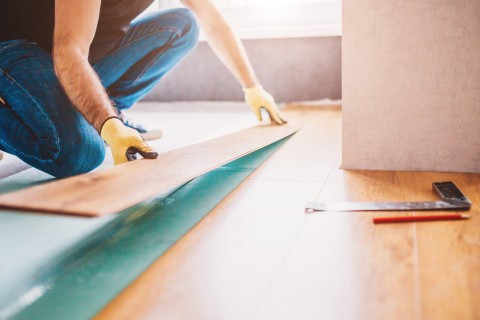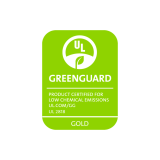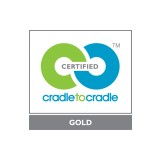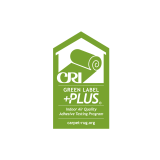

Choosing and Installing Healthier Flooring
Flooring is found in every room in every building, and is susceptible to getting scratched and degraded more quickly than other materials, releasing its chemical makeup into the indoor environment. This problem is exacerbated as flooring ages and deteriorates, leaving new exposure pathways for occupants. Low-income residents are put at an even greater risk as affordable housing rental units are likely to have cheaper, older flooring. While affordability of flooring is important, it is equally important that floors in affordable housing are durable and do not contain hazardous chemicals.
Children under the age of six are especially vulnerable to the chemical hazards of flooring as they spend more time on the floor, have a higher incidence of hand-to-mouth behavior, have higher levels of absorption, have a faster inhalation rate and smaller body mass, and experience rapid nervous system development.
| Type of Flooring | Chemicals of Concern | Health Concerns | Healthier Option |
|---|---|---|---|
| Natural linoleum | None | None | Linoleum is a safe product |
| Prefinished solid wood floors | None | None | Prefinished solid wood floors are safe products |
| Ceramic tiles | Antimicrobials, heavy metal contaminants in imported tiles | Bacterial resistance, endocrine disruption | Buy U.S.-made products, buy unglazed tiles, avoid antimicrobials. |
| Solid wood floors (site-finished) | Aluminum oxide protective layer, antimicrobials, VOCs in finishes | Cancer, asthma trigger, endocrine disruption | Avoid products labeled as antimicrobial |
| Cork floors | Binders containing isocyanates (more of an issue in manufacturing) | Asthma from isocyanates (in manufacturing) | Buy prefinished cork and install it as a floating floor. Avoid products with topcoat layer of PVC |
| PVC-free resilient flooring | Polyethylene, polypropylene, ethylene vinyl acetate, polyester, and acrylics | Asthma, birth defects | PVC-free resilient flooring is much preferred to vinyl flooring |
| Engineered wood | Formaldehyde binders, isocyanates, VOCs in finishes | Cancer, asthma trigger | Buy pre-finished, buy with NAF (no added formaldehyde) binders or at least NAUF (no added urea formaldehyde), avoid antimicrobials. |
| Laminates | Formaldehyde binders, VOCs in adhesives, heavy metal contaminants in imported laminates | Cancer, gene damage, asthma trigger, skin and eye irritant, birth defects | Buy U.S.-made products, buy with NAF (no added formaldehyde) binders or at least NAUF (no added urea formaldehyde), buy flooring that does not require adhesives for installation. |
| Carpet | Coal fly ash filler in backings, perfluorinated compounds (PFCs), antimicrobial additives, vinyl backings, dust trapped in carpets, phthalates, lead | Bacterial resistance, cancer, developmental problems and birth defects, reproductive disruptor | Buy carpets without stain resistant and antimicrobial treatments, find carpet backings using ground glass instead of coal fly ash as filler, avoid vinyl backings. |
| Vinyl | Phthalate plasticizers, heavy metal stabilizers (organotins), halogenated flame retardants, contaminants such as arsenic in recycled content, VOCs in finishes | Cancer, developmental problems and birth defects, reproductive disruptor, decrease fertility, kidney damage, bone loss | Not preferable, if necessary buy vinyl that has been reformulated to be free of hazardous phthalate plasticizers |
Flooring Adhesives
When choosing healthier flooring, the installation method and associated adhesives need to be considered as well as the flooring material. While flooring itself can contain many hazardous chemicals, many flooring types also require adhesives that have associated health risks.
| Type of Adhesive | Chemicals of Concerns | Health Concerns | Used with |
|---|---|---|---|
| Acrylic/Latex (water based) | Phthalates (still remain in some; most use healthier benzoate plasticizers) | Reproductive, developmental effects, respiratory problems | Carpet, vinyl, engineered wood |
| Epoxy | Bisphenol A (BPA), nonylphenol ethoxylates (NPEs) | PBT, cancer, endocrine and reproductive disruptor, respiratory irritation, gene mutation | Linoleum, vinyl |
| Polyurethane | Isocyanates, organotin, petroleum distillates, dibutyltin | PBT, cancer, birth defects, asthma trigger | Vinyl |
| Mortars, Grouts (Thin-Set), Cementitious Systems | VOCs, mildew-cides, antimicrobials, fly ash (heavy metals), silica | Cancer, kidney damage, liver damage, reproductive health, antibiotic resistance, central nervous system damage, silicosis | Ceramic tile |
| Silicone | Cyclosiloxanes, organotin catalysts, VOCs, dibutyltin dilaurate | PBT, reproductive toxicity, endocrine disruptor, infertility | Laminate, linoleum, vinyl, engineered wood, ceramic tile, carpet |
Flooring that can be installed through mechanical means such as staples, nails, or tongue and groove mechanisms are preferred to flooring requiring adhesives. If choosing carpet, a healthier option is “peel-and-stick” adhesives already attached to the carpet backing, similar to double-sided tape, which have relatively low VOC off-gassing.
Healthier Flooring
Look for these product labels:






| Avoid | Good | Better | Best |
|---|---|---|---|
Vinyl flooring Flooring containing recycled content PFAS-based stain and oil repellents (water- and stain- repellency) Flooring advertised as anti-microbial | Carpeting and rubber tile that are certified to be free of the most hazardous chemicals | PVC-free resilient flooring Low-VOC certified and pre-finished engineered wood and laminate Site-finished hardwood flooring with low-VOC stains or finishes Pre-finished cork flooring | Pre-finished wood flooring Linoleum Concrete flooring (without densifiers containing PFAS) US made ceramic tile |
Other flooring recommendations
- If vinyl flooring is the only option cost-wise, avoid vinyl products that use recycled content and ask for the phthalate-free options.
- Aim to install “floating” flooring, which does not require use of adhesives. Floating flooring is readily available for laminate, vinyl, and engineered wood flooring and often is cost comparable.
- When adhesives are necessary, choose products that have a no-added formaldehyde (NAF) certification. If this is not possible, look for other certifications such as ultra-low emitting formaldehyde (ULEF) or no-added urea formaldehyde (NAUF). These products have passed the California Air Resources Board standards and are certified by an approved third-party certifier. Also look for adhesives that are labeled “No VOC” or “Low VOC”; generally these will be water-based solutions.
- Laminate flooring and engineered wood also can contain formaldehyde. Similar to adhesives, look for products that have ULEF or NAF certifications.
- When given the option between pre-finished and unfinished hardwood or engineered wood, it is best to go with pre-finished so that off-gassing will occur at the factory and not in your home.
- When installing ceramic tiles, prefer concrete grouts in powder form, and avoid products with VOCs, fly ash, mildew-cides, and antimicrobials.
- Prefer flooring methods with mechanical installation, peel and stick, or interlocking tiles. For adhesives, prefer acrylic over epoxy and polyurethane.
Recycled Flooring
While recycled content may sound like a positive sustainability measure, recycled content in building products is risky from a health perspective. When using recycled content, manufacturers can introduce toxic legacy chemicals from older products. This problem is especially persistent in recycled vinyl, where legacy substances used in PVC products, such as lead, cadmium, and phthalates, can show up in new flooring manufactured from recycled vinyl. The Ecology Center measured heavy metals in recycled content vinyl flooring, with results showing some floors contained as much as 1 percent lead and 2 percent cadmium, a very high amount of lead that would be the equivalent of one hundred times the allowed amount in toys.